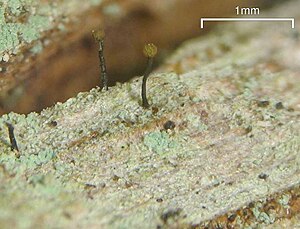Coniocybaceae
| Coniocybaceae | ||||||||||||
|---|---|---|---|---|---|---|---|---|---|---|---|---|

|
||||||||||||
| Systematics | ||||||||||||
|
||||||||||||
| Scientific name of the class | ||||||||||||
| Coniocybomycetes | ||||||||||||
| M. Prieto & Wedin | ||||||||||||
| Scientific name of the order | ||||||||||||
| Coniocybales | ||||||||||||
| M. Prieto & Wedin | ||||||||||||
| Scientific name of the family | ||||||||||||
| Coniocybaceae | ||||||||||||
| Rchb. |
According to the current state of research (as of May 2018), the family of the Coniocybaceae is the only family of the order of the Coniocybales within the only class of the Coniocybomycetes .
features
The Coniocybaceae form crusty lichens with green algae of the genera Dictyochloropsis , Stichococcus , Trentepohlia (algae) or a trebouxioid photobiont . Many are inconspicuous, but some species are brightly colored. The fruiting bodies , the apothecia , are stalked and form a spherical to almost conical head, which gives the fruiting body the appearance of a pin. Therefore these types, but other families like the Calycidiaceae and Mycocaliciaceae , pin lichen called. The excipulum is weak to well developed, formed as a transition between the stem tissue. A macaedium , i.e. the powdery mass of spores, hyphae and paraphyses , is always present.
Their thin-walled tubes are cylindrical, ellipsoidal or irregular and dissolve at an early stage. They are formed from hyphae that can have a hook (so-called croziers), are single or in chains. The spores are simple, spherical to ellipsoidal and pale to brown. They are mostly unseptate , rarely with one to five septa. They are smooth or with a warty or cracked ornament . No pycnidia are known in nature , only from axenic cultures of some Chaenotheca species. Simple secondary crop forms have been observed from culture, but also in nature. Pulvin- and vulpinic or their derivatives are used primarily in the cortex (the pruina), rarely in thallus ago. Atranorin , Baeomycesinsäure and Squamatinsäure occur in some species.
Ecology and diffusion
Coniocybaceae are mostly lichen formers with green algae on dry wood or similar substrates. They are widespread.
Systematics and taxonomy
The family was described by Ludwig Reichenbach as early as 1837 and, like all pin braids, was placed in the order of the Caliciales sensu lato and of an uncertain systematic position within the hose fungi. In 2013, Maria Prieto and Mats Wedin showed that the three groups of pin lichen Caliciales, Mycocaliciales and the Coniocybaceae are systematically far apart, and therefore described the class of Coniomycetes with the only order Coniocybales and their only family Coniocybaceae. They chose Coniocybe as the type genus . But this is now a synonym for Chaenotheca . Therefore, at the moment only two genera belong to the Coniocybaceae:
- Chaenotheca
- Sclerophora
Individual evidence
- ↑ a b c d e f g Maria Prieto, Elisabeth Baloch, Anders Tehler and Mats Wedin: Mazaedium evolution in the Ascomycota (Fungi) and the classification of mazaediate groups of formerly unclear relationship . In: Cladistics . tape 29 , 2013, p. 296–308 , doi : 10.1111 / j.1096-0031.2012.00429.x ( PDF ).
- ^ A b c d Paul F. Cannon, Paul M. Kirk: Fungal families of the world . CABI Europe, Wallingford, Oxfordshire (UK) 2007, ISBN 978-0-85199-827-5 , pp. 84 ( available online - 456 pages).
- ↑ Johannes Bradtka, Claus Bässler & Jörg Müller: Tree-dwelling lichens as indicators for process protection and ecological continuity in the Bavarian Forest National Park . In: Forest ecology, landscape research and nature conservation . tape 9 , 2010, p. 49-63 ( PDF ).
- ↑ Coniocybomycetes . In: MycoBank . Mycobank, accessed June 7, 2018 .
- ↑ Nalin N. Wijayawardene, Kevin D. Hyde, H. Thorsten Lumbsch, Jian Kui Liu, Sajeewa SN Maharachchikumbura, Anusha H. Ekanayaka, Qing Tian, Rungtiwa Phookamsak: Outline of Ascomycota: 2017 . In: Fungal Diversity . tape 88 , 2018, p. 167-263 , doi : 10.1007 / s13225-018-0394-8 .